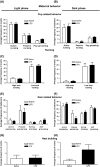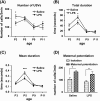Neonatal behavioral changes in rats with gestational exposure to lipopolysaccharide: a prenatal infection model for developmental neuropsychiatric disorders
- PMID: 20805287
- PMCID: PMC3329978
- DOI: 10.1093/schbul/sbq098
Neonatal behavioral changes in rats with gestational exposure to lipopolysaccharide: a prenatal infection model for developmental neuropsychiatric disorders
Abstract
Exposure to prenatal infections has been widely associated with the increased risk for neuropsychiatric disorders of developmental origin such as schizophrenia and autism. Although several behavioral and cognitive deficits have been detected during adulthood in rodent models of prenatal infections, early behavioral changes have not been well characterized. In a prenatal lipopolysaccharide (LPS) model, we have previously observed significant alterations in the neuronal cytoarchitecture during early postnatal life. In the present study, we aimed to investigate the potential effects of prenatal immune activation on early neurophenotypic presentations using a set of behavioral test battery. Female Sprague-Dawley rats were administered with 100 μg/kg LPS (intraperitoneally) at gestational days 15 and 16. During the first postnatal week, we found no significant effect on maternal behavior or mother-pup interaction by this treatment. Also, no major changes in physical developmental milestones of pups were noted from postnatal (P) days P6 to P16. Importantly, prenatal LPS-exposed pups had a significant decrease in the number and duration of ultrasonic vocalization calls at P3 and P5. Prenatal LPS treatment also led to impairments in nest-seeking behavior and odor-stroke associative learning in neonatal rats at P8 and P9. At the molecular level, we detected significant decrease in the expression of cortical 5HT1A and 5HT1B messenger RNA at P3. These data suggest that prenatal exposure to an immune activator can significantly impair the social/communicative behavior in the neonate offspring, which may be relevant to childhood and premorbid abnormalities reported in autism and schizophrenia subjects.
Figures





References
-
- Boksa P, El-Khodor BF. Birth insult interacts with stress at adulthood to alter dopaminergic function in animal models: possible implications for schizophrenia and other disorders. Neurosci Biobehav Rev. 2003;27:91–101. - PubMed
-
- Khashan AS, Abel KM, McNamee R, et al. Higher risk of offspring schizophrenia following antenatal maternal exposure to severe adverse life events. Arch Gen Psychiatry. 2008;65:146–152. - PubMed
-
- Brown AS, Begg MD, Gravenstein S, et al. Serologic evidence of prenatal influenza in the etiology of schizophrenia. Arch Gen Psychiatry. 2004;61:774–780. - PubMed
Publication types
MeSH terms
Substances
Grants and funding
LinkOut - more resources
Full Text Sources
Other Literature Sources
Medical
Research Materials
Miscellaneous

